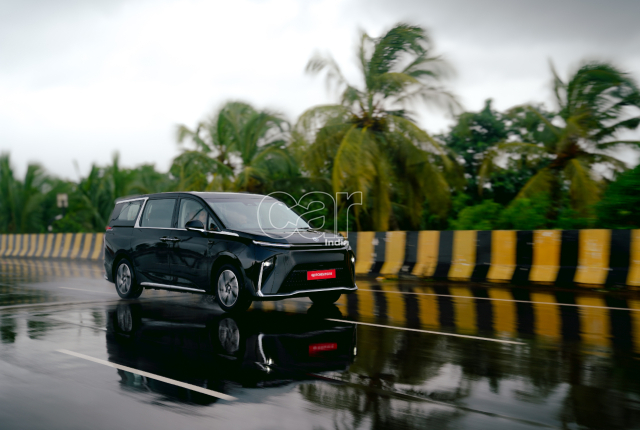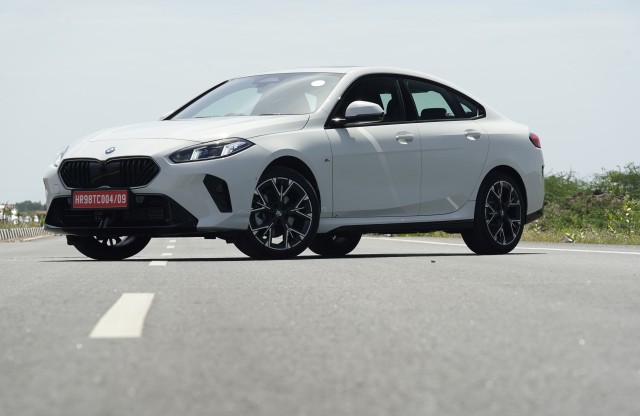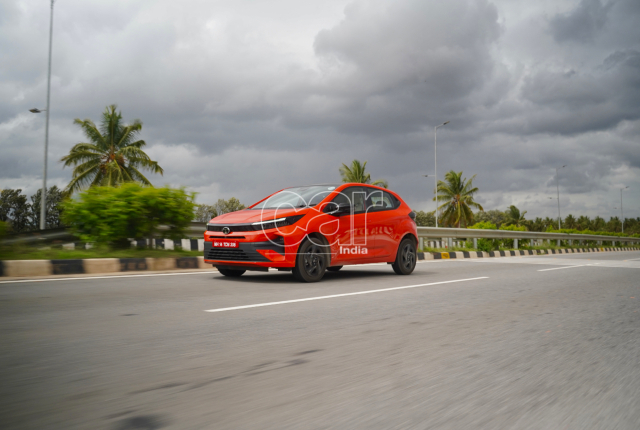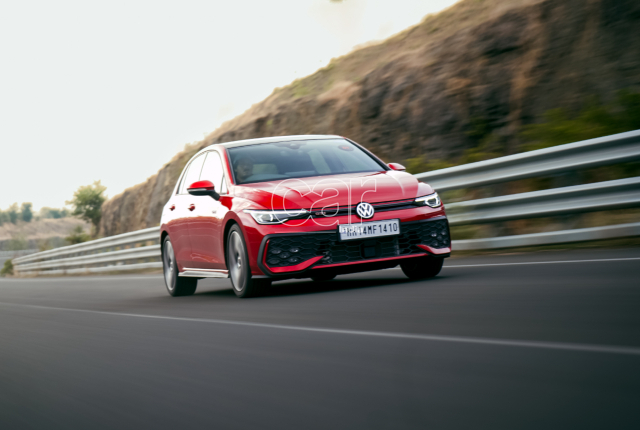 Company
Company
The Linea threatens to kill with its looks as Bunny Punia
gets caught in a crossfire between the Italian and the
Americans
Photography Sanjay Raikar
Â

There’s more to Italy than piza and pasta. Besides the allure of Sicilian women, the work of great Italian artists can be viewed in museums worldwide. Their great motoring marques engender a unique sense of passion in drivers and car enthusiasts. Some of the best looking cars in the world were sketched in various Italian design centers. The only Italian car company in India, FIAT hasn’t exactly lived up to the tradition of making gorgeous pieces of art on four wheels. The FIATs of yesteryears were nice and the more recent Palio too looked classy, at least on the outside. Yet I can’t help but wonder; has the Italian marque forgotten its roots? One look at FIAT’s latest baby for the Indian market, the Linea and you will be screaming ‘Hell No’! Just like the Mafiosi that the Italians are infamous for, it looks like the new C segment contender is loaded with enough ammunition for an aggressive assault on the competition. Although delayed by months, can the FIAT Linea overthrow its closest Indian rivals, the Ford Fiesta and the Chevrolet Optra Magnum?
Among the three top of the line diesel models, it is the Linea that demands a second glance. Curvaceous with the right angles, this FIAT is a bold departure from the cars we are used to seeing on Indian roads. Based on an extended Grande Punto platform (a car that literally saved FIAT from going bankrupt), the Linea is a work of art. At least I think so. Its huge size can shame other cars in this segment for sheer road presence. The car’s exterior styling is elegant, dynamic and typically Italian. The pulled back twin pod headlamps with a rather huge two part grille dominate the front. There are no sharp edges instead there is a seamless flow of body lines. The swooping A pillar as well as the way the roof meets the C pillar and the boot impart a grand look to the car. The rear is equally eye catching with a bulged rear windscreen and a muscular boot lid.
 |
 |
|  Though it seems lik the Linea’s interior is directly copied from the grande punto, it is a step forward in the right dirction. bright fabric for the seats add an airy feel. |  After powering the swift, the Ozire, the indica and FIAT’s own palio,this multijt engine is now seen in the linea.Power though is at healthy 90bhp. |
The competition, on the other hand, fails to match the Linea for sheer graceful looks. The Fiesta clearly feels like a smaller car. Almost eleven inches off the Linea’s length, the Ford is also narrowest of all the three cars. The Fiesta was revamped with fresh sportier looks recently but it’s a shame Ford isn’t giving the racy body kit (found on the S petrol model) as an option on the diesel variant. It doesn’t have the same eye catching appeal that the Linea or for that matter, the Optra has to an extent. The car is also a hit with the taxi segment and that does hinder its brand image a bit. The Optra Magnum looks posh. Most Optras sold are in black and our test car too came in the same shade. With a rather sharp and low front end, the narrow tear drop like headlamps are flanked on either side of the chrome lipped grille. The Chevy almost matches the Fiat in length, though it is lowest in height here. The rear of the Optra with a small chrome lip and vertically stacked small tail lamps looks equally pleasing. Both the Linea and the Optra come with 15-inch alloy wheels as standard for the top end model, though the Fiesta has to do with full size covers for its 14-inch wheels.
Rich black and cream interiors of the Linea greet you on the inside. A lot of attention seems to have been given to the car’s interior styling. The lines are harmonious and well balance with the exterior creating a friendly, light filled environment. As far as ergonomics is concerned, the Linea scores high. The multi-functional steering wheel with thumb rests feels great to hold. It comes with controls for music, Blue&Me system, etc., but what really gets your attention is the white speedometer console. The Linea has one of the best looking consoles around with loads of info on display. There are two dedicated trip meters, each with average and instantaneous fuel consumption, average speed and distance run. The silver finish central console looks equally appealing, however, look closely and the quality of plastics doesn’t feel upto the mark. The music system is quite good and the automatic climate control is easy to operate. Shift action is precise though the ratios are smaller – more on that later. The armrest is a boon for comfort while cruising on the highway, although it obstructs the hand while changing gears. Vanity lights are also a welcome feature. It is a surprise to see FIAT opting for fabric covers for the seats and door trim instead of leather for the top end version. Though it does give an airy feel, with time, the bright material will be prone to dirt marks. Seating is comfortable up front with impressive leg and knee room.
At the rear, the dedicated aircon vents earn brownie points and so does the visor blind. The rear armrest has two cup holders though they feel light and poorly built. One issue bothering me is the car’s low roof. Most of us had an issue with sitting upright at the rear. We also found the rear legroom to be slightly on the tighter side for full size adults.

 FORD FIESTA 1.4 TDCI
The Fiesta’s insides in comparison appear opulent. Leather seats do the trick and the quality of the fascia is good too. The steering wheel is meaty and the twin clock speedometer console looks sporty as well. The Fiesta also scores high in space up front as well as at the rear. However, the Optra is the most spacious of the lot here. You do sit a little lower but nonetheless have a great view of the road. The car feels quite wide from the inside and full leather interiors with liberal use of beige impart a luxurious feel. The aircon vents are chromed and clever use of wooden inserts try hard to justify the car’s price tag. You can even flip the rear seats to access the boot. There is a rear armrest, though the omission of vanity lights is not welcome. An integrated stereo system would have done wonders to the car’s interior, which looks rather low-rent being fitted with an aftermarket player.The diesel engine under the hood of these three cars are as different as chalk and cheese. At just 68bhp of power and 160Nm of torque on paper, the Fiesta seems to be underpowered. Drive the car for a few kilometers though, and the 1.4-litre DuraTorq engine will delight you with one of the best combinations of performance, low end punch and fuel economy. For city driving, it seems to be the best bet here. The car’s terrific throttle response and agility help negotiate the worst any city can throw at you in terms of traffic. But show it a stretch of open road, stomp the accelerator and you will be somewhat disappointed. As the tachometer needle rises, the engine starts dying. Anything over 3000rpm, and the motor seems to be running out of breath. This is also reflected in the acceleration timings as a 0-100km/h dash takes 16.83sec making it lag behind the other two cars. It even loses out for the top speed stakes, hitting a true speed of 160km/h in fifth, though it does happily cruise at 110-120km/h without a protest. The car returns good fuel economy figures of 14kmpl in city and best in class 25kmpl on the highway at sedate speeds.
The Chevrolet is a hoot to drive. Below 2000rpm it feels anemic but anything over that and it seems like a caged beast has been set free. Torque steer is evident and once the engine rpm is in the meaty band, nothing stops the Optra from blistering past traffic. 11.58sec is all it takes to reach the ton mark; another 11 and it is past 140km/h! The 120PS 2-litre engine further makes the car kiss the 200km/h mark on the speedometer. Now, that is your everyday diesel saloon acting like a petrol car on steroids. The downside, however, is the engine’s sleepy nature for city driving. The power jump once you get close to 2000rpm is sudden and can be irritating in slow moving traffic and fuel consumption is impressive too – 15kmpl in city and 21 on the highway.
Â

CHEVYOPTRA 2.0 TDCI
The Linea’s powerplant feels like a combination of both the above cars. It has a decent punch for city driving and once the variable vane turbo is at its peak, it performs well too. It uses FIAT’s renowned 1.3-litre Multijet engine that also does duty on other Indian cars. This one though is in a higher state of tune, producing 90bhp of power with 200Nm of torque. In city driving, the engine feels smooth and refined with enough juice to close in on gaps. But hit the highway and the shorter gearing shows its flaws. Due to the engine running at higher rpms for any given speed and not so good NVH levels, a lot of noise filters into the cabin. Long trips can be irritating in this car. The shorter gearing also means that the 0-100km/h timing is affected as you have to shift up to the third cog just before the ton mark to get the best figures – that’s two shifts to reach 100km/h as compared to one for the other cars. Still, the FIAT manages to post a 15.07sec timing and a top whack of 168km/h. Fuel efficiency in the city is good, though due to short gearing, highway economy takes a hit. 14.5kmpl in city and 22 on the highway is what the car managed. Note that for all the three cars, highway fuel efficiency figures were derived at speeds of 85-90km/h with the aircon switched off.
After the photo shoot of the three cars, we had planned to hit the twisties of Lonavala for a small break. I started with the Linea first and was utterly surprised with its predictable behavior. The steering feels light yet had oodles of feedback and the grip from the Goodyear GT3s was phenomenal. A stiff suspension set up also aids in the way the car feels on curves. The Linea follows the line you intend to take exactly. Low speed ride is on par with the other two cars, though as speeds build up, there is no denying the fact that the Linea scores high. It feels like a much bigger, expensive car and soaks major undulations without feeling unsettled even for a bit. The Fiesta, due to small 14-inch wheels and the smallest wheelbase doesn’t feel as inspiring when driven spiritedly. It feels more like a car meant for the city – agile and responsive. The car’s suspension works respectably over any given road condition and feels stable at highway speeds. We would have swapped the small wheels for the 15-inch ones that are sold for the Sport petrol variant as it does make a world of difference to the way the Ford responds when given the stick. The Optra rides the way a posh luxurious car should. The suspension is tuned more for comfort and is slightly on the softer side. Highways are where this car belongs. At 140km/h, the Optra feels right at home. It will even glide over bad roads without jarring the occupants. However, on hills, there is a lot of body roll and you have to correct the steering and be gentle on the accelerator throughout. 15-inch Goodyear GT3s do duty here as well and impress. All the three cars come with airbags (single for the Fiesta) and ABS as standard on the top end variants.

Â





















Leave a Reply